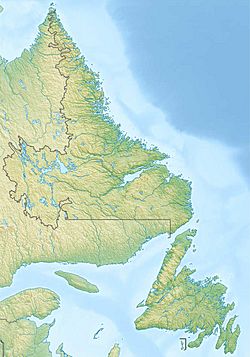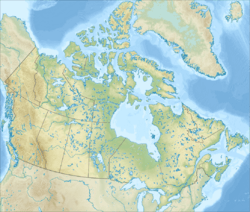Black Tickle facts for kids
Quick facts for kids
Black Tickle-Domino
|
|
|---|---|
|
Local service district / designated place
|
|
| Country | Canada |
| Province | Newfoundland and Labrador |
| Region | Labrador |
| Census division | 10 |
| Census subdivision | B |
| Government | |
| • Type | Unincorporated |
| Area | |
| • Land | 9.43 km2 (3.64 sq mi) |
| Population
(2021)
|
|
| • Total | 87 |
| Time zone | UTC−04:00 (AST) |
| • Summer (DST) | UTC−03:00 (ADT) |
| Area code(s) | 709 |
Black Tickle (which is Kikkertet in Inuttitut) is a small community in Newfoundland and Labrador, Canada. It's located on a place called the Island of Ponds. This area is also part of the NunatuKavut territory, which is a homeland for some Indigenous people.
In 2021, about 87 people lived in Black Tickle. It's interesting because this community, and others south of it in Labrador, use Newfoundland Time. This is different from most other communities in mainland Labrador, which use Atlantic Standard Time.
You can't reach Black Tickle by road. The only way to get there is by flying into Black Tickle Airport, which has a gravel runway, or by taking a ferry. The ferry, called MV Kamutik W., runs from June to November, connecting Black Tickle with Goose Bay and Cartwright.
Contents
A Look at Black Tickle's History
What Happened in Black Tickle?
Black Tickle has faced some challenges over the years. In 2012, the local fish plant, which was an important place for jobs, had to close down. This was a big change for the community.
In 2016, there was worry that Black Tickle might lose its full-time nurse, and even its fuel supply for the cold winter months. This would have made life very difficult for the people living there. Luckily, good news came later that year: the full-time nurse was able to stay.
More recently, in 2021, the town worked with an Indigenous company to get a new and reliable fuel supply. This was a great step forward for the community's future.
Polar Bears in the Area
Since 2015, Black Tickle has been in the news for a surprising reason: polar bears! There have been many sightings of these large animals near the community.
Where is Black Tickle Located?
Understanding Black Tickle's Geography
Black Tickle-Domino is found on the northwestern tip of the Island of Ponds. This island is just off the coast of southwestern Labrador. It's part of a larger area known as Division No. 10 in Newfoundland and Labrador.
How Many People Live Here?
Population Changes in Black Tickle
The number of people living in Black Tickle has changed over time. Here's a quick look at the population:
|
|||||||||||||||
According to the 2021 Census, 87 people lived in Black Tickle-Domino. This was a decrease from 150 people in 2016. The community has a land area of about 9.43 square kilometers (about 3.64 square miles).



